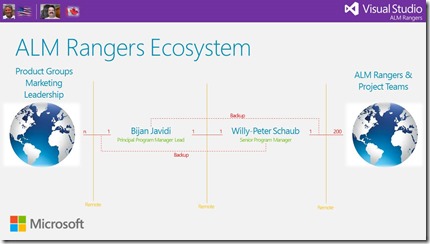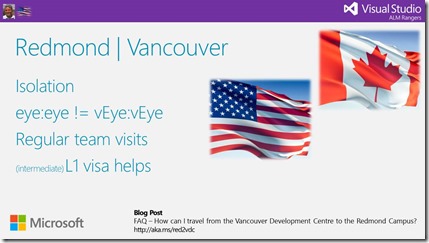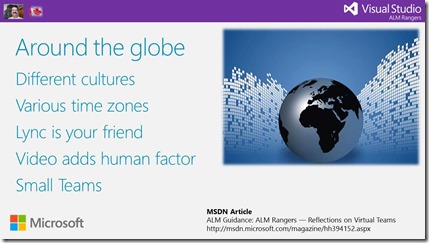FAQ: Remote Teams and Managers … a feasible scenario?
We had an interesting brownbag discussion at the Vancouver Development Centre yesterday. Here are three of the slides and the nuggets that emerged from the discussions.
We are in essence bridge builders, connecting the product groups, marketing and leadership, with up to 200 ALM Rangers scattered across the globe, time zones and infrastructure topologies. Our recommended ALM Rangers project team consists of:
The PO is typically located on the left-hand side of the bridge and the rest on the right hand-side. Remote team and managers are therefore part of every ALM Ranger team ecosystem, even before the team engages reviewers and early adopters. |
 |
| Isolation is a problem and while some thrive in isolation, others need constant buzz and activity around them. If the latter applies, ensure that you engage with your colleagues using video conferencing technologies, such as Lync, and limit “working from home” :) Personally I work best sitting in the middle of Semiahmoo Bay at low tide, but I need to collaborate with my teams and I value the precious face to face time in Redmond, or sitting with phenomenal colleagues like Charles Sterling “Chuck” over a “real” beer and burger. Eye to eye collaboration is definitely the best, because you can perceive not just audio, but facial expressions and feedback … not to mention being able to walk up to a whiteboard, scribble and discuss. Plan regular team visits, meet face to face and get to know the humanoid behind the virtual online names. For those travelling between the Redmond and Vancouver development centre (FAQ – How can I travel from the Vancouver Development Centre to the Redmond Campus?) it is worth talking to your manager and HR to organize an intermediate L1 visa. Border crossings are easier and you are actually allowed to be productive while you are in the US and do work :) Be careful with visa waivers and B* visas, which have restrictions in terms of “doing work”, often forcing you to sit on your hands while visiting the Redmond teams. Going to the US be ready to answer question related to “why are you entering the US” and going to Canada “what are you bringing with you”. If you travel to the US every second week, as I do, you get used to explaining why you have an intermediate L1 yet live in Canada, why you take the bus instead of driving yourself, why you need to visit your remote teams and why you would work through the night instead of booking a hotel. |  |
When collaborating / communicating with remote teams around the world it is important to remember the different cultures, characters and time zones. While some people take to online meetings like a Duck to water, others battle with the virtual world.
Discuss the challenges and options of online meetings with your remote colleagues. If they understand the challenges and see the value of video, for example, they will make every effort to bring a laptop to their meetings and talk to you vFace to vFace :) |
 |
To summarize, three points of advice:
|
Do we believe it is a feasible scenario? We, the ALM Rangers, have and are living in this scenario every day of our exciting days … our response is therefore a definite yes!